The French are known for many things: art, fashion, wine, and food, to name a few. And one of the most famous delicacies that people around the world have come to love is the French pastry.
French bakeries, known as boulangeries and patisseries, are renowned for boasting a selection of exquisite pastries for every taste. From savory to sweet, pastry-making is considered a high art. Young apprentice pâtissiers and chefs in France typically starting learning their craft at 16-18 years old.
And what makes French pastries so exquisite? It is usually the choice of fresh ingredients and age-old techniques, combined with creativity to push the boundaries of traditional cuisine.
So let’s uncover the best French pastries that will have you wanting more, shall we? Allons-y!
- 1. Croissants
- 2. Macarons
- 3. Pain au chocolat (Chocolatine)
- 4. Eclairs
- 5. Chouquette
- 6. Chausson aux pommes
- 7. Millefeuille
- 8. Beignets
- 9. Profiterole
- 10. Brioche
- 11. Palmiers
- 12. Gauffres
- 13. Kouign-amann and Kouignettes
- 14. Paris-Brest
- 15. Tarte Tatin
- 16. Suisse biscuit
- 17. Galette des rois
- 18. Religieuse
- 19. Croquembouche (Piece montée)
1. Croissants
Legend has it that the croissant was a tradition that the young Marie-Antoinette of Austria brought with her to France, when she married French King Louis XVI. Hence it became known as a viennoiserie or “thing from Vienna (the capital of Austria)”.
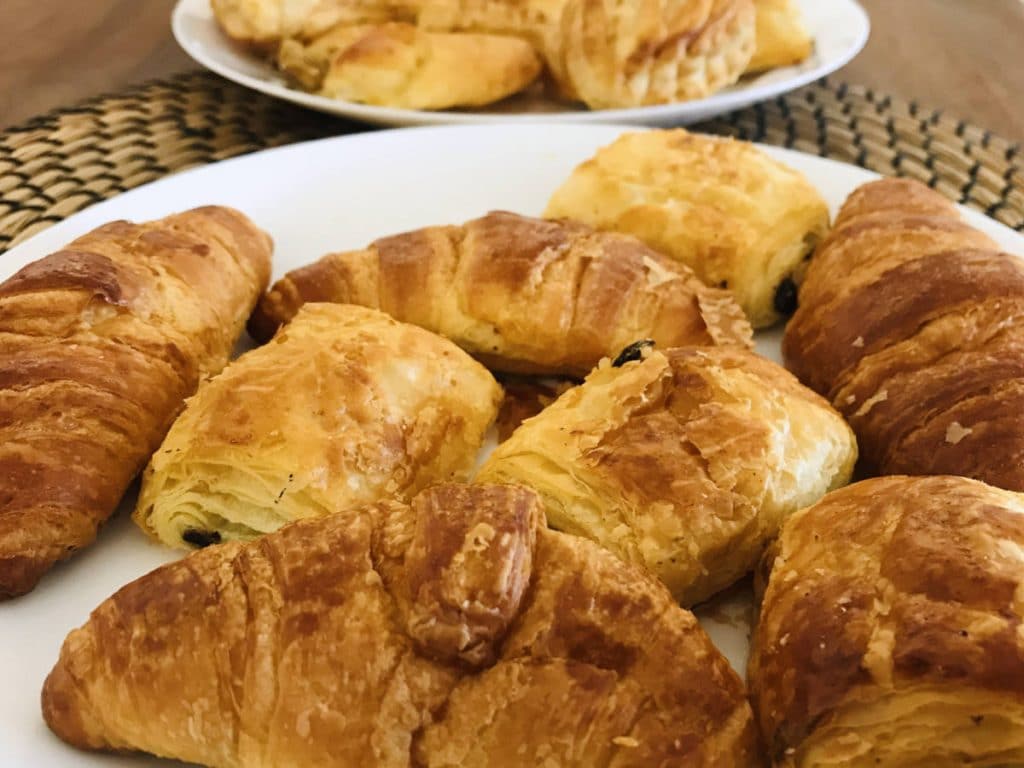
Today, croissants and other viennoiseries like pain au chocolat, chausson aux pommes, etc. are an indelibly considered French foods (although, the Austrians might disgree).
Originally, croissants were made from a brioche cake-like base but later evolved to a buttery and flaky dough (pâte feuilletée). While you can find croissants all over the world these days, there is nothing like a french croissant, light and airy fresh out of the oven.
2. Macarons
Macarons might be as ubiquitous in North America today as the cookie is in France, but there’s still something to be said to having one freshly prepared at a traditional French patisserie.

If you are in Paris, try the macarons at at Pierre Hermé, Ladurée, or Café Pouchkine near Place de la Madeleine.
3. Pain au chocolat (Chocolatine)
The debate has lasted for centuries: is it a pain au chocolat or a chocolatine? If you are from Paris and the north of France it is a pain au chocolat, but in the south-west of France it is a chocolatine.
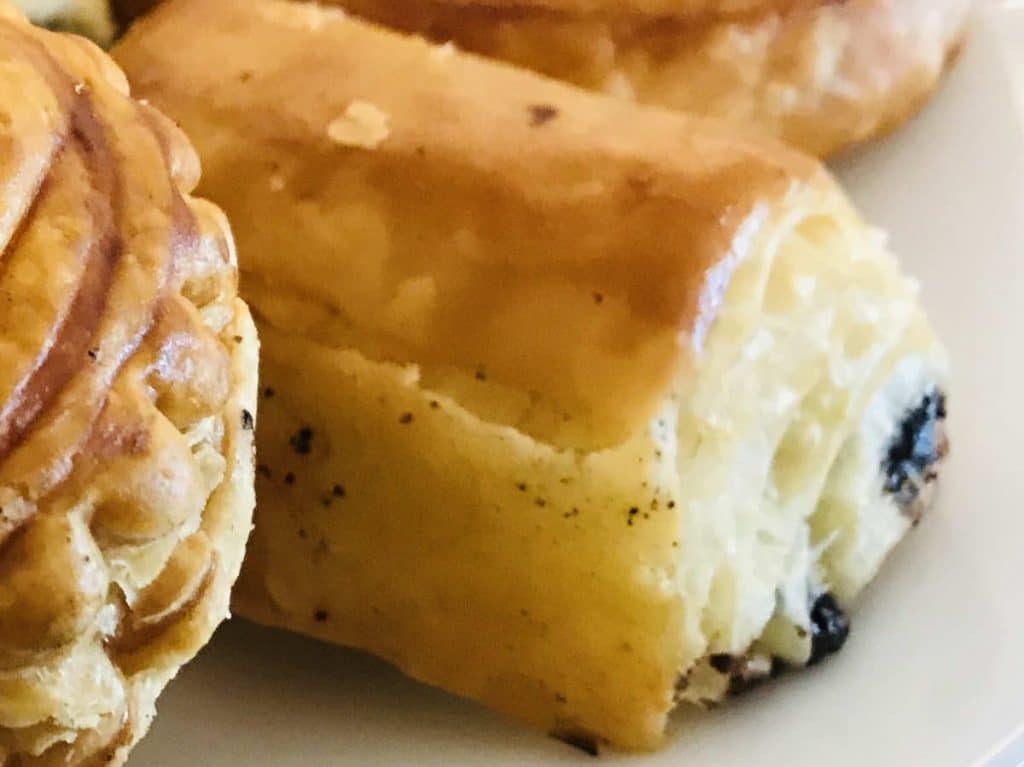
Made from the same pastry layers as a croissant with chocolate added to it, pain au chocolat literally translates to “chocolate bread”.
In the French part of Belgium, it is referred to as couque au chocolat, while the Quebecois also call it chocolatine. And the Germans? They call it schokoladencroissant. In all, a debate that is bound to continue.
4. Eclairs
The grand classic of French desserts is of course the chocolate eclair. An oblong pastry, stuffed with cream and custard, and topped off with chocolate icing.
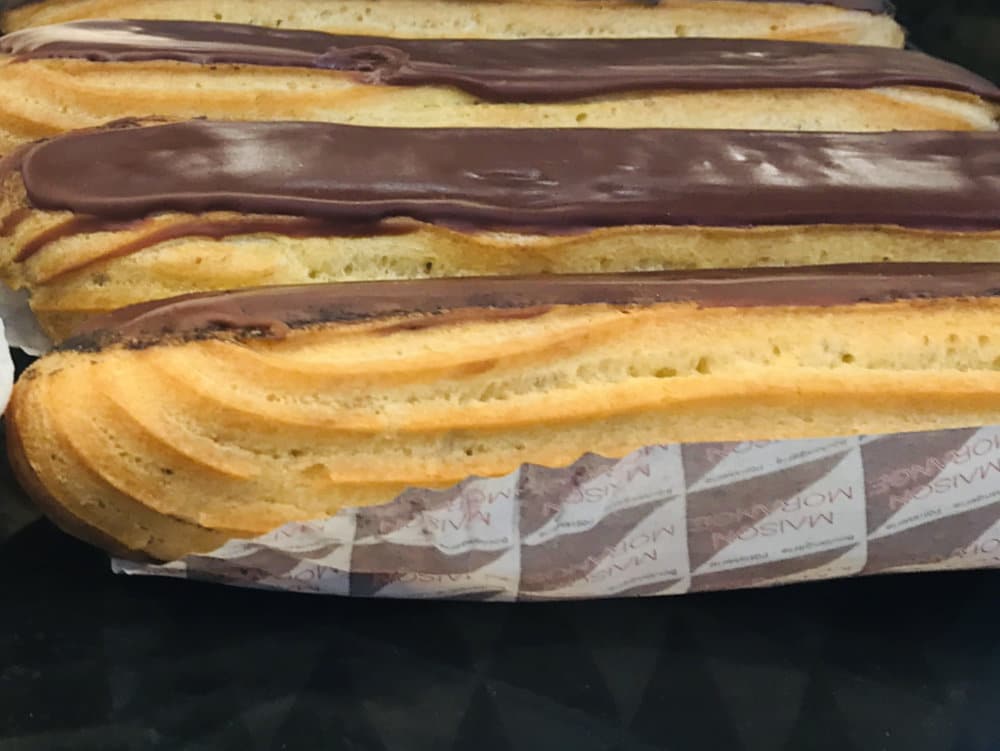
Forget the pastry filled with industrial sugar that you get in North America, and try one in Paris at one of the city’s famed patisseries like Ladurée and Angelina‘s.
5. Chouquette
A chou is a French nickname meaning “small and cute”, and as you can imagine the chouquette is equally small and cute. A small round pastry ball it is often topped with pearled sugar or chocolate.

These small bite-sized pastries were originally thought to be made from leftover dough, as a small snack. Unlike éclairs which have a filling inside, a chouquette is usually hollow on the inside.
The gougères filled with cheese is sometimes referred to as a savory version of the chouquette.
6. Chausson aux pommes
Using a similar pâte feuilletée as the croissant and pain au chocolat, a chausson aux pommes is made from adding cooked apples into the middle of the pastry, and then folding it in half before baking.
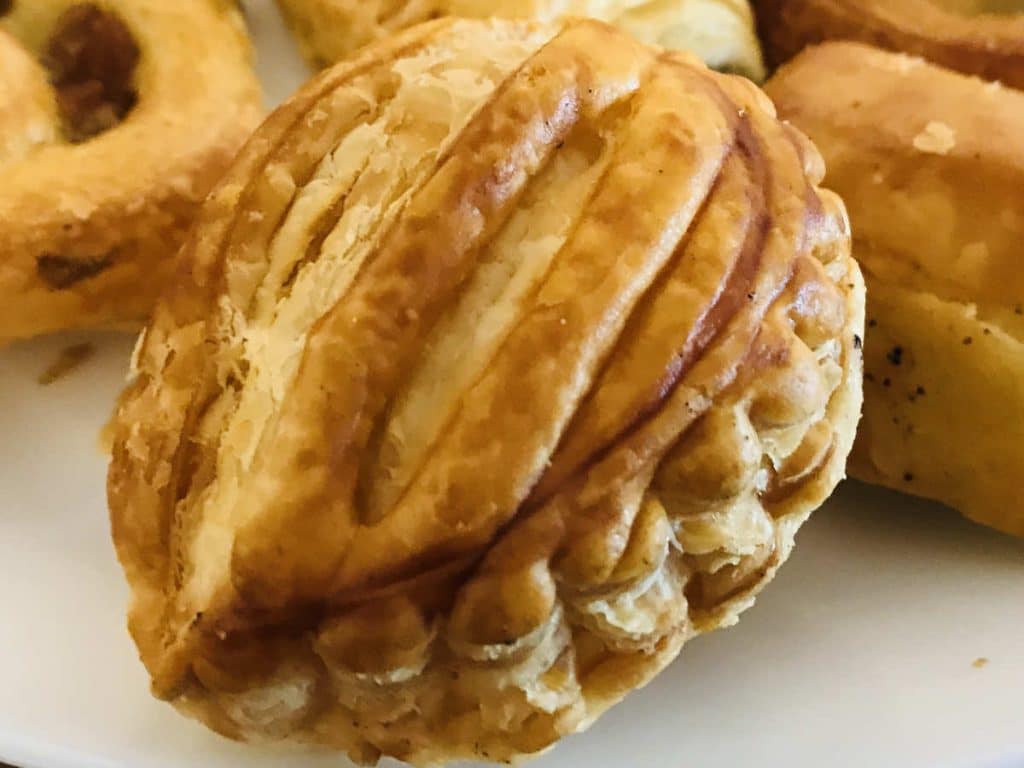
It is believed to originate from the region of Sarthe and Moselle in the north of France.
An annual festival called the Fête du Chausson aux Pommes has been celebrated since 1630 in September in the town of Saint-Calais in the Loire region.
7. Millefeuille
An exquisitely complicated dessert to make, the mille feuille means 1000 layers, and is composed of layers of puff pastry and cream. It is sometimes also called the gâteaux Napoléon.

The pastry is folded several times, which is why it is called mille feuille, and the butter cream filling then added to the layers and cooled overnight.
Fun fact: The French love of paperesse is called the “millefeuille administrative”.
8. Beignets
Beignet is the French word for “donuts”, although if you looked at them you may not necessarily recognize as a donut.
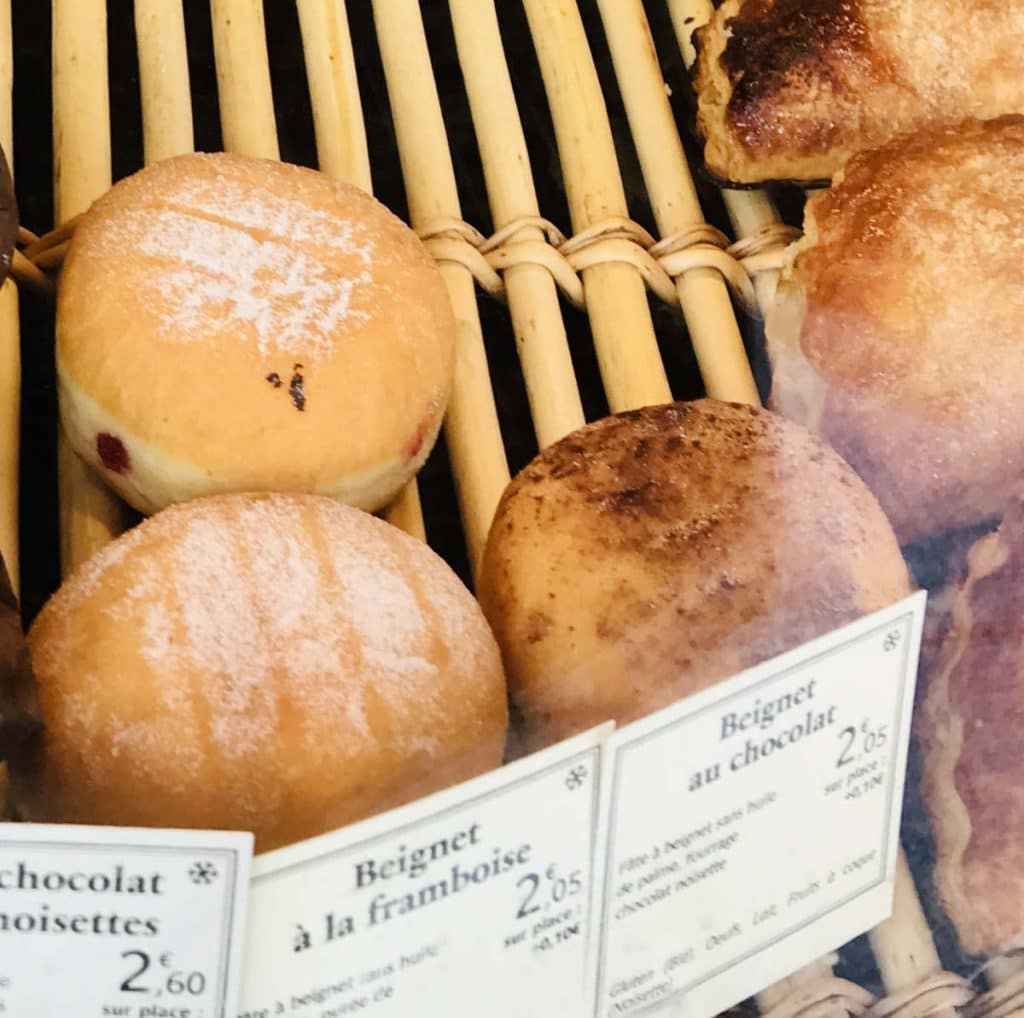
Dating back to the 13th century in France, these balls of dough sometimes contain a filling like a fruit compote, jam, or chocolate. They are then fried in butter.
Each region in France has their own beignet, with the most popular varieties being:
- Beignets bretons – from Brittany
- Bougnettes – in Pays Catalan (near Spain)
- Bugnes – in Savoy and Lyon
- Chichi frégi – Provence
- Fantaisies – Burgundy
- Faverolles or frivolles – in Champagne
- Fritelles – in Corsica
- Ganses – in Nice
- Oreillettes – in Languedoc
- Risoles – in Jura (served during New Year)
- Schankala – in Alsace (during carnival)
9. Profiterole
A profiterole is another chou pastry, but unlike the chouquette, it is filled with butter or vanilla cream.

Usually topped with chocolate syrup, they can also be topped with sugar or other creams.
They became world-famous when renowned French chefs like Antoine Beauvilliers and Marie-Antoine Carême wrote about them in their cookbooks during the 19th century.
10. Brioche
A brioche is a light sweet bread containing eggs and butter. It is a cross between a bread, a cake, and a viennoiserie (pastry) and is believed to originate from Normandy in the 16th century.
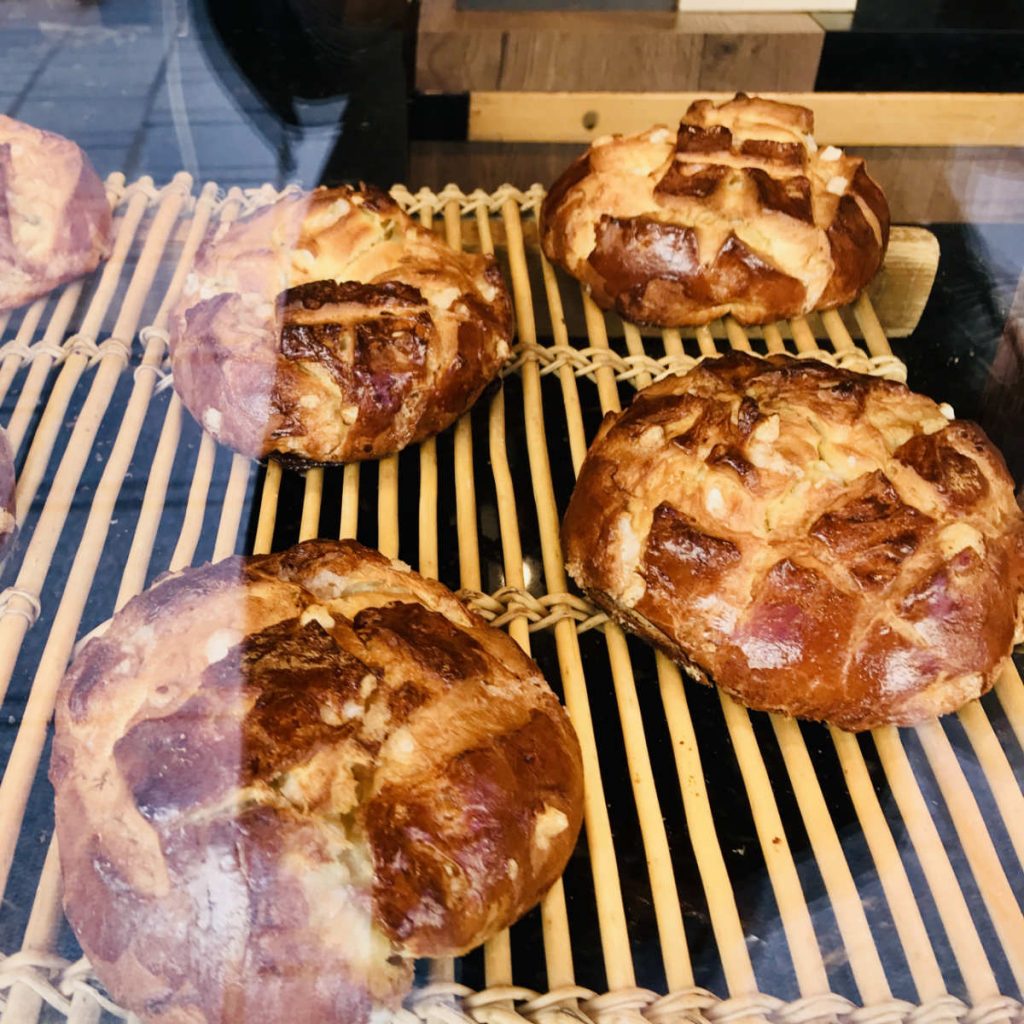
The purportedly famous saying by Marie-Antoinette was actually “Qu’ils mangent de la brioche!“, not “cake”, which is gâteau in French.
There are several types of brioches, with each region having its own recipe and speciality:
- Brioche Parisienne – the classic brioche made from butter, eggs, milk, flour, sugar, salt, yeast. Brioche de Paris is recognizable for its shape, made up of two superimposed balls, the smaller one on top of a larger one.
- Brioche de Nanterre – the historic brioche dating back to the days of Saint Genevieve in 450 AD. Unlike the brioche parisienne, the brioche de Nanterre is rectangular and made up of balls of dough placed side by side.
- Brioche tressée de Metz – a braided brioche (three pieces of dough braided together) from Metz during festive occasions.
- Brioche au sucre – brioche with small bits of sugar on the crust.
- Brioche vendéenne – a large round brioche that is sometimes called the pain de Pâques, as it is usually served for Easter (and sometimes during weddings in the Vendée region of France.)
- Cougnou – a brioche that is eaten in December during the period of Saint Nicholas and Christmas. It is oval-shaped with a decoration in the middle to look like a baby Jesus swaddled and lying down.
- Tarte tropézienne – a brioche shaped like a cake that is flavored with the orange flower water. In the middle, it is filled with a butter cream and a custard.
11. Palmiers
Palmiers are small puff pastry biscuits that are shaped in the form of the top of a palm tree (called a “palmier” in French).
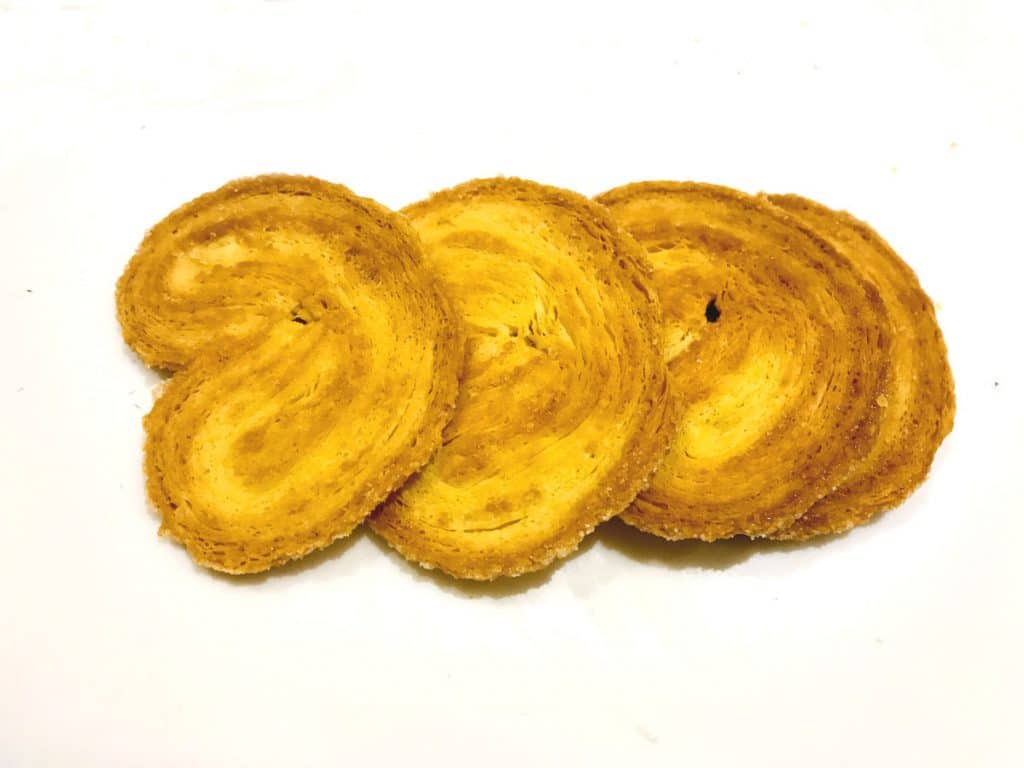
The dough used is similar to the croissant, except without yeast, so it does not rise but remains in biscuit form. They are known as palmeras in Spain, and orejas (ears) in Latin America.
12. Gauffres
Gauffres, or waffles as they are called in English, are a specialty in the north of France and Belgium.
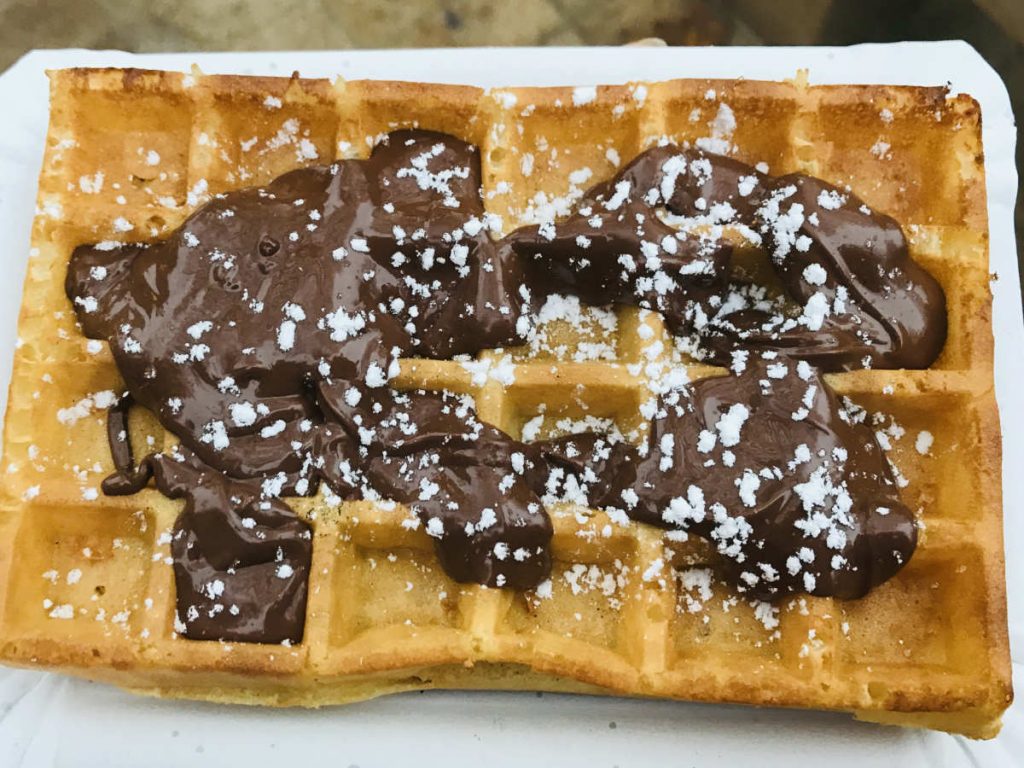
A pastry made with a light dough, they are baked in a waffle iron consisting of two metal plates that leave tile-shaped square imprints in the dough.
They are usually served as a dessert since the dough is sweetened, and topped with fruit, chantilly, chocolate, or other creams.
13. Kouign-amann and Kouignettes
A speciality in Brittany, kouign-amann stands for “cake” and “butter” in the local Breton language.

It was believed to have been invented around 1860 at a time when flour was lacking while butter (and milk from cows) was abundant. As such, the proportions are a little unusual, with 400 grams of flour for 300 grams of butter.
A kouignette just is an individual size version of the kouign-amann, which is often eaten as a snack.

14. Paris-Brest
A Paris-Brest is a donut-shaped pastry filled with praline cream. It isn’t the lightest dessert on the list, but it is definitely one to try (and share with a friend).

The dessert was created in 1891 to commemorate the creation of a long distance bicycle race (the predecessor of the Tour de France.) Brest is a city on the coast of Bretagne (Brittany), and the bicycle race went from Paris to Brest and back.
The Paris-Brest bicycle race ended in 1951, but its namesake dessert lives on.
15. Tarte Tatin
Each region in France has its favorite tart. The tarte tatin comes from the Loire region, courtesy of the Tatin sisters, Stephanie and Caroline who invented it at the end of the 19th century.
It is aa variation of the tarte aux pommes (apple pie) where the apples are caramelized and often dough cooked on top.

Another variation is the Norman tart, which is an apple pie with a filling made of flour, eggs, cream, sugar and a little calvados.
In the Savoy (Alsace), there is the tarte aux myrtilles (meaning “blueberry pie”). A traditional dessert, blueberries grow bountiful in the Alps, making this pastry dish a popular treat after the September harvest.
You can find many varieties of tarts served as desserts in restaurants all over France, as well as local patisseries and boulangeries.
16. Suisse biscuit
One of the specialities of Valence (near Lyon) is that it is known for a type of biscuit called the Suisse. It is a orange blossom shortbread cookie in the shape of a soldier.
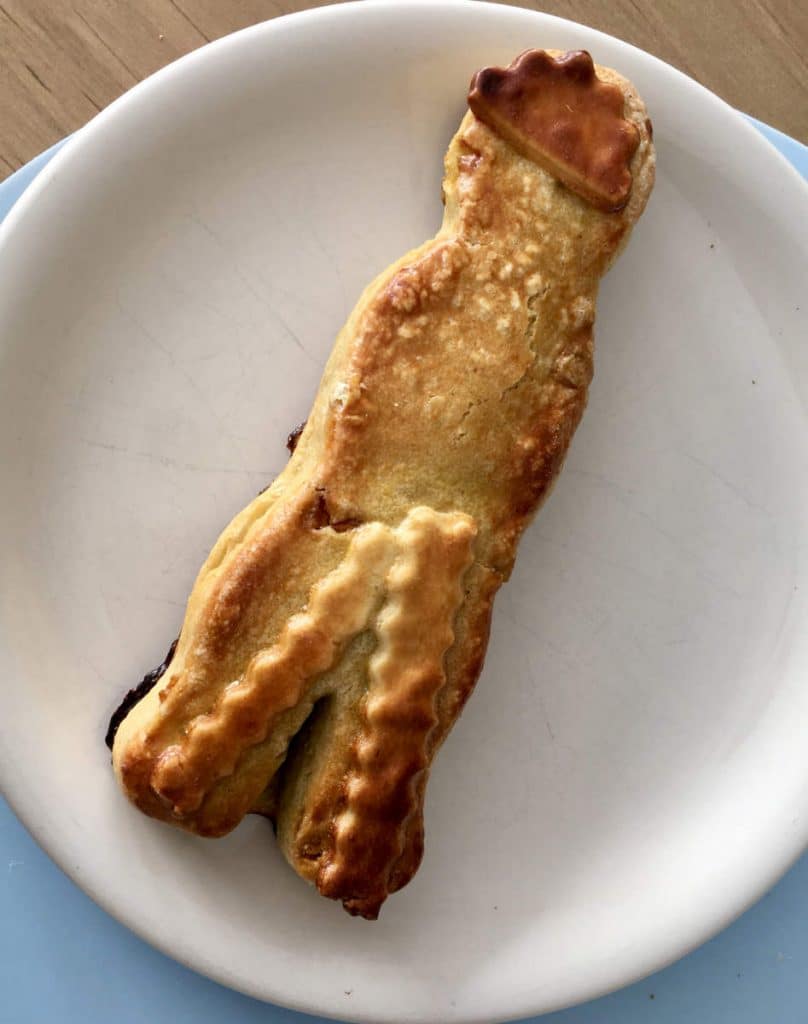
It is not well-known even to French locals from other regions, but it is a favorite amongst children in Valence. The story of the Suisse biscuit dates back to the 18th century when Catholic Pope Pius VI is taken prisoner by then General Napoleon Bonaparte.
Pope Pius VI was held in Valence where he died on August 29, 1799 and was buried in Valence Cathedral. The Suisse biscuit was created to represent his personal protection, for the Suisse bodyguards who protect the pope and the papacy.
You can find the Suisse biscuit in boulangeries (bakery) all over Valence. It is usually eaten as a treat for goûter (meaning “after-school-snack”) and especially served up at Easter.
17. Galette des rois
If it is early January, you will likely find your local French patisserie packed with people trying to buy a galettes des rois. And that is because this treat is especially reserved for 3 Kings’ Day or Jour de l’Epiphanie.
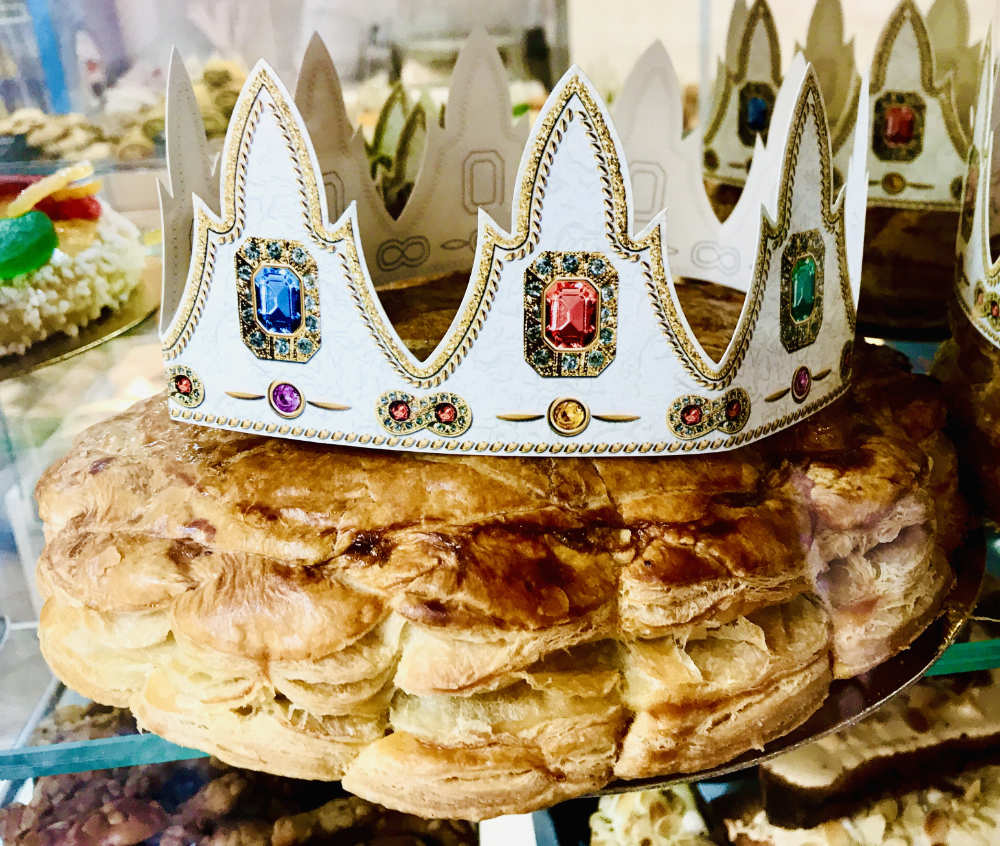
The galette des rois is a type of pancake made from pastry that has been browned in the oven. It is sometimes filled with frangipane, fruits or creams.
18. Religieuse
The name religiouse means “nun”, but there is nothing nun-like about this dessert.

It is made with two choux pastry, one larger than the other and filled with crème. It can also be filled with chocolate or mocha cream. It is then usually covered on top with chocolate icing.
19. Croquembouche (Piece montée)
You won’t see a piece montée unless you go to a traditional French wedding, but if you do, you should definitely try it. Instead of elaborate cake, weddings in France usually have a doughy pastry pyramid called the croquembouche or la piece montée.
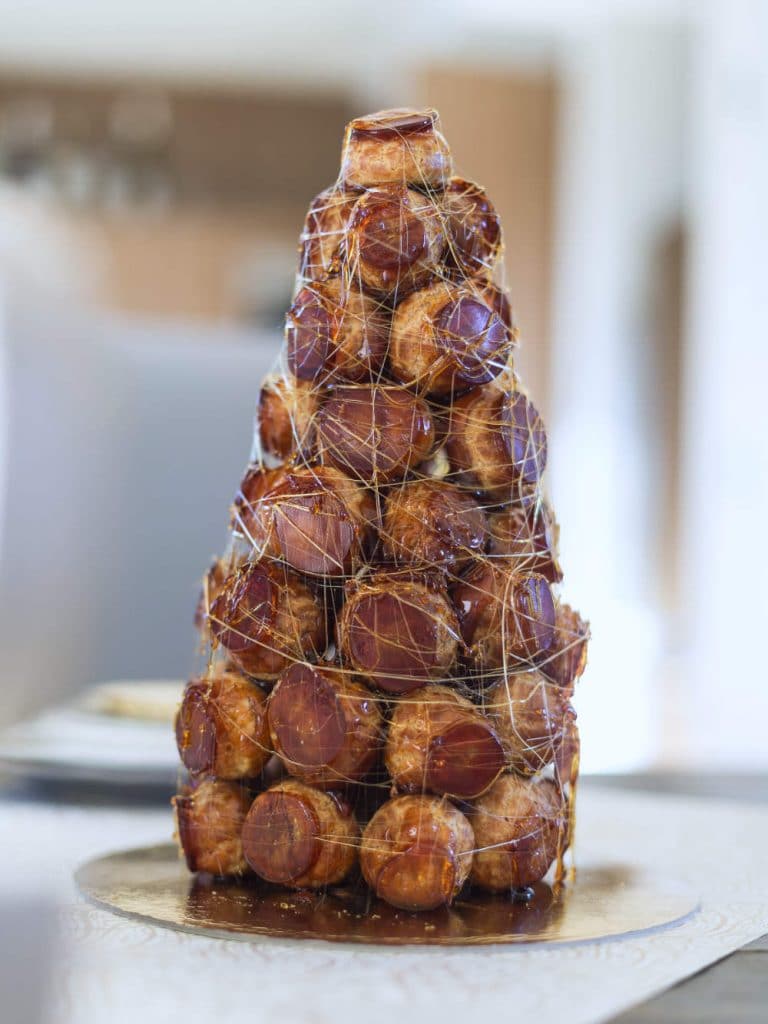
This literally translates to bite in the mouth and is made out of small choux pastries. If you do want to try a pâte à choux without going to a wedding, you can easily try them at your local French patisserie.

If you enjoyed that article, you may like to read more about other traditional French foods and drinks. A bientôt!




